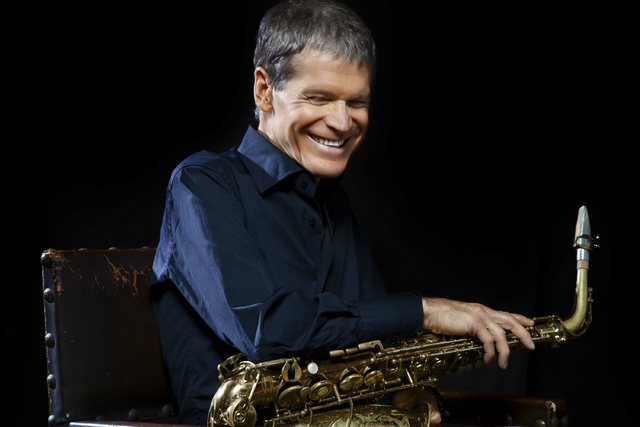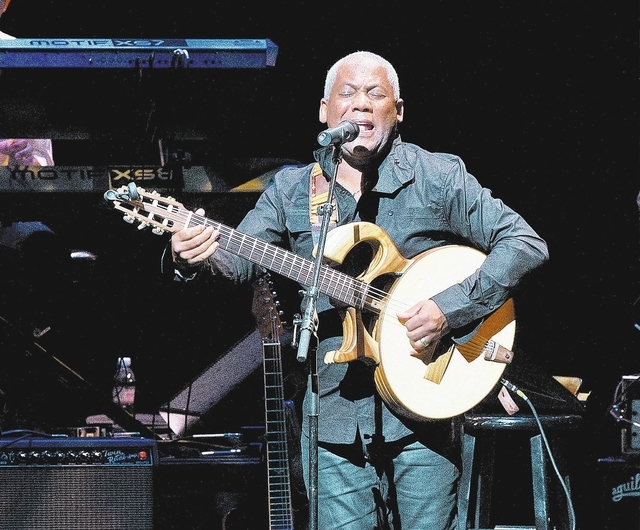Saxophonist David Sanborn, singer-guitarist Jonathan Butler team for ‘Satin & Soul’ Smith Center concert
Saxophonist David Sanborn and singer-guitarist Jonathan Butler grew up worlds apart — Sanborn in the U.S., Butler in South Africa.
But there’s one thing the two have in common: a lifelong love of music that began in childhood.
Make that two things in common, the second being Friday’s Jazz Roots concert in The Smith Center’s Reynolds Hall.
Billed as “Satin &Soul,” it’s a musical double feature, with Sanborn and his band up first, followed by Butler and company — including Butler’s daughter, Jodi.
Although Sanborn and Butler have performed on jazz cruises, “we’ve never really worked together,” Sanborn says in a telephone interview from his East Coast base. “We do two completely different things.”
But they’ve definitely got a mutual-admiration thing going.
“I think he’s great,” Sanborn says of Butler. “He’s very versatile — he’s got a lot of talent.”
And Butler’s been “a huge fan” of Sanborn’s music since the ’70s and ’80s. “He’s all music,” Butler says of Sanborn. “Guys like David Sanborn have said it all.”
But, Sanborn cautions, he won’t be playing it all at Friday’s concert.
Those fans who favor the pop-flavored side of his repertoire will be hearing “more of a jazz thing,” although “not straight-ahead jazz,” according to the saxophonist.”
It’s not going to be a retrospective,” in part because of his backing lineup: an organist and drummer.
“It’s definitely a different vibe” than the “more electric, funk” side he’s displayed in some of his solo work — and collaborations with pop, rock and soul fixtures from Paul Simon and James Taylor to David Bowie and Eric Clapton, James Brown and Stevie Wonder.
That mix of musical influences first piqued Sanborn’s interest in music — and the saxophone.
As a boy, Sanborn contracted polio when he was 3, spending a year in an iron lung and another year paralyzed from the neck down.
“I was bedridden a lot,” he says simply, recalling that “music was so cinematic. It created this whole other world. I wanted to be inside this world of sound.”
Sanborn got his chance at 11, when doctors suggested playing a wind instrument would be good therapy for him.
He opted for the saxophone, in part because “it was the instrument of the times,” turning up on the rhythm and blues records he liked most, from Little Richard to Fats Domino — and especially Ray Charles.
Charles and his sax players, David “Fathead” Newman and Hank Crawford, delivered a musical “mix of jazz, gospel and R&B — and I had never heard that mix,” Sanborn says.
Mixing musical styles and genres has become a Sanborn signature — and so has his resistance to being pigeonholed.
“It’s not in my nature to do one particular thing,” he says, noting that sometimes his music could be classified as “funk, R&B and jazz,” while “sometimes it’s in between all those. I don’t think in those categories.”
Not that it’s been a problem for Sanborn, 68, who’s released two dozen albums — and won six Grammy Awards — during a career that’s still in gear, almost four decades after his solo career took off in 1975 with the appropriately titled “Taking Off.”
And although “certain things can lean more toward the pop end of the spectrum,” Sanborn says of his music, “sometimes you can be in that gray area” that “resists classification.”
Butler, by contrast, plans to lead the audience “on a journey,” tracing his path, which leads from Africa to Britain to the U.S.
Wherever he went, however, Butler’s music went with him.
Now 52, Butler began performing when he was 7 — and “it was definitely my idea,” he says during a telephone interview from his Southern California home. “Music is everything I have. It’s what I wanted to do.”
Music also “was a thread that ran through our family,” he adds. “When times were tough, the one ingredient that would make us happy was music.” Beyond that, “I felt, when I sang, that people were happy.”
And “nothing pleased me more” than to share that happiness, Butler notes. “To me, it’s more than entertainment — it’s what I feel I’m called to do in this life I’m living.”
That feeling only increased, 35 years ago, when Butler became a born-again Christian and his perspective widened to include a message along with the music.
At the start of his career, Butler admits to using “gimmicks and stuff, just to be noticed,” he says. “Now, it’s more ministry.”
And though “the music is still me, and it’s going to come out in its true form,” Butler promises.
Despite his focus on faith, however, Butler promises there will be a “greatest hits” aspect to his Smith Center performance.
“As artists we all get sick of singing the same songs over and over,” especially when “there’s so much more that’s on our records,” in Butler’s view. “But that’s part of the business. That’s what put you there.”
Besides, there’s a special glow “when people sing your song in their language,” he notes, citing a recent trip to Indonesia and the Philippines. (In his native South Africa, “people sing every instrumental and every vocal song” along with him.)
When Butler began performing, he recalls, Stevie Wonder was a particular inspiration — especially because “he was an original,” one of the “artists who write their own material.”
His example helped Butler become one too, using music in “telling my own story.” And, after more than two dozen recordings, it’s a story he knows well.
Sanborn also believes in musical self-expression.
“You make the music you hear in your head,” he explains. “You can’t predict what it’s going to be.”
Which is exactly the way he likes it.
“You want to be surprised,” Sanborn says. “That’s the goal: to always be surprised.”
Contact reporter Carol Cling at ccling@reviewjournal.com or 702-383-0272.
Preview
"Satin & Soul" with David Sanborn and Jonathan Butler
7:30 p.m. Friday
Reynolds Hall, The Smith Center for the Performing Arts, 361 Symphony Park Ave.
$26-$99 (702-749-2000, www.thesmithcenter.com)























